曼昆宏观经济学第28章
- 格式:pdf
- 大小:4.09 MB
- 文档页数:43
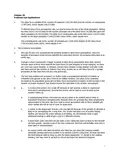
Chapter 28Problems and Applications1. The labor force consists of the number of employed (142,076,000) plus the number of unemployed(7,497,000), which equals 149,573,000.To find the labor-force participation rate, we need to know the size of the adult population. Adding the labor force (149,573,000) to the number of people not in the labor force (76,580,000) gives the adult population of 226,153,000. The labor-force participation rate is the labor force (149,573,000) divided by the adult population (226,153,000) times 100%, which equals 66%.The unemployment rate is the number of unemployed (7,497,000) divided by the labor force(149,573,000) times 100%, which equals 5.0%.2. Many answers are possible.3. Men age 55 and over experienced the greatest decline in labor-force participation. This wasbecause of increased Social Security benefits and retirement income, encouraging retirement at an earlier age.4. Younger women experienced a bigger increase in labor-force participation than older womenbecause more of them have entered the labor force (in part because of social changes), so there are more two-career families. In addition, women have delayed having children until later in life and have reduced the number of children they have, so they are in the labor force for a greater proportion of their lives than was the case previously.5. The fact that employment increased 1.5 million while unemployment declined 0.6 million isconsistent with growth in the labor force of 0.9 million workers. The labor force constantlyincreases as the population grows and as labor-force participation increases, so the increase in the number of people employed may always exceed the reduction in the number unemployed.6. a. A construction worker who is laid off because of bad weather is likely to experienceshort-term unemployment, because the worker will be back to work as soon as theweather clears up.b. A manufacturing worker who loses her job at a plant in an isolated area is likely toexperience long-term unemployment, because there are probably few other employmentopportunities in the area. She may need to move somewhere else to find a suitable job,which means she will be out of work for some time.c. A worker in the stagecoach industry who was laid off because of the growth of railroads islikely to be unemployed for a long time. The worker will have a lot of trouble findinganother job because his entire industry is shrinking. He will probably need to gainadditional training or skills to get a job in a different industry.d. A short-order cook who loses his job when a new restaurant opens is likely to find anotherjob fairly quickly, perhaps even at the new restaurant, and thus will probably have only ashort spell of unemployment.e. An expert welder with little education who loses her job when the company installsautomatic welding machinery is likely to be without a job for a long time, because she lacksthe technological skills to keep up with the latest equipment. To remain in the weldingindustry, she may need to go back to school and learn the newest techniques.12 Chapter 28/Unemployment7. Figure 2 shows a diagram of the labor market with a binding minimum wage. At the initial minimumwage (m1), the quantity of labor supplied L1S is greater than the quantity of labor demanded L1D, and unemployment is equal to L1S−L1D. An increase in the minimum wage to m2 leads to anincrease in the quantity of labor supplied to L2S and a decrease in the quantity of labor demanded to L2D. As a result, unemployment increases as the minimum wage rises.Figure 28. a. Figure 3 illustrates the effect of a union being established in the manufacturing labormarket. In the figure on the left, the wage rises from w1U to w2U and the quantity of labordemanded declines from U1 to U2D. Because the wage is higher, the quantity supplied oflabor increases to U2S, so there are U2S−U2D unemployed workers in the unionizedmanufacturing sector.b. When those workers who become unemployed in the manufacturing sector seekemployment in the service labor market, shown in the figure on the right, the supply oflabor shifts to the right from S1 to S2. The result is a decline in the wage in thenonunionized service sector from w1N to w2N and an increase in employment in thenonunionized service sector from N1 to N2.Chapter 28/Unemployment 3Figure 39. a. When the Japanese developed a strong auto industry, U.S. auto demand became moreelastic as a result of increased competition. With more elastic demand for autos, theelasticity of demand for American autoworkers increased.b. Because the rise in auto imports made the demand for autoworkers more elastic, tomaintain a higher-than-competitive wage rate requires a greater reduction in the quantityof labor demanded. So the union had to choose between allowing the union wage todecline or facing the loss of many jobs.c. Given the trade-off faced by the union, the growth of the Japanese auto industry forcedthe union wage to move closer to the competitive wage.10. a. If a firm was not providing such benefits prior to the legislation, the curve showing thedemand for labor would shift down by exactly $4 at each quantity of labor, because thefirm would not be willing to pay as high a wage given the increased cost of the benefits.b. If employees value the benefit by exactly $4 per hour, they would be willing to work thesame amount for a wage that's $4 less per hour, so the supply curve of labor shifts downby exactly $4.Figure 4c. Figure 4 shows the equilibrium in the labor market. Because the demand and supply curvesof labor both shift down by $4, the equilibrium quantity of labor is unchanged and thewage rate declines by $4. Both employees and employers are just as well off as before.d. If the minimum wage prevents the wage from falling, the result will be increasedunemployment, as Figure 5 shows. Initially, the equilibrium quantity of labor is L1 and theequilibrium wage is w1, which is $3 lower than the minimum wage w m. After the law ispassed, demand falls to D2 and supply rises to S2. Because of the minimum wage, thequantity of labor demanded (L2D) will be smaller than the quantity supplied (L2S). Thus,there will be unemployment equal to L2S–L2D.4 Chapter 28/UnemploymentFigure 5Figure 6e. If the workers do not value the mandated benefit at all, the supply curve of labor does notshift down. As a result, the wage rate will decline by less than $4 and the equilibriumquantity of labor will decline, as shown in Figure 6. Employers are worse off, because they now pay a greater total wage plus benefits for fewer workers. Employees are worse off,because they get a lower wage and fewer are employed.。
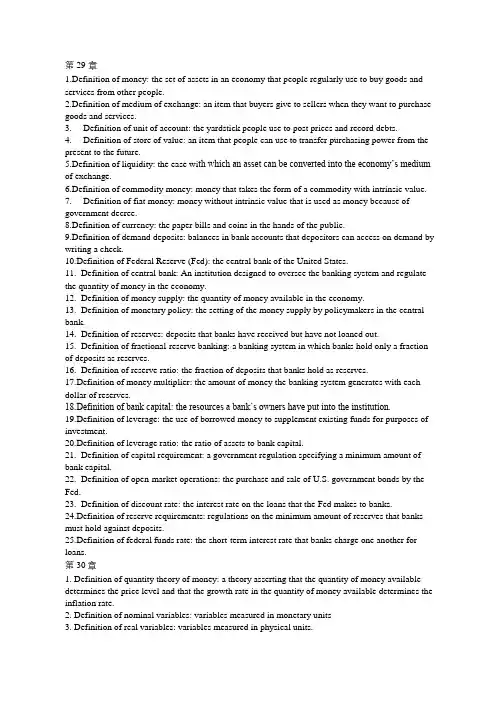
第29 章1.Definition of money: the set of assets in an economy that people regularly use to buy goods and services from other people.2.Definition of medium of exchange: an item that buyers give to sellers when they want to purchase goods and services.3. Definition of unit of account: the yardstick people use to post prices and record debts.4. Definition of store of value: an item that people can use to transfer purchasing power from the present to the future.5.Definition of liquidity: the ease wi th which an asset can be converted into the economy’s medium of exchange.6.Definition of commodity money: money that takes the form of a commodity with intrinsic value.7. Definition of fiat money: money without intrinsic value that is used as money because of government decree.8.Definition of currency: the paper bills and coins in the hands of the public.9.Definition of demand deposits: balances in bank accounts that depositors can access on demand by writing a check.10.Definition of Federal Reserve (Fed): the central bank of the United States.11. Definition of central bank: An institution designed to oversee the banking system and regulate the quantity of money in the economy.12. Definition of money supply: the quantity of money available in the economy.13. Definition of monetary policy: the setting of the money supply by policymakers in the central bank.14. Definition of reserves: deposits that banks have received but have not loaned out.15. Definition of fractional-reserve banking: a banking system in which banks hold only a fraction of deposits as reserves.16. Definition of reserve ratio: the fraction of deposits that banks hold as reserves.17.Definition of money multiplier: the amount of money the banking system generates with each dollar of reserves.18.Definition of bank capital: the resources a bank’s owners have put into the institution.19.Definition of leverage: the use of borrowed money to supplement existing funds for purposes of investment.20.Definition of leverage ratio: the ratio of assets to bank capital.21. Definition of capital requirement: a government regulation specifying a minimum amount of bank capital.22. Definition of open-market operations: the purchase and sale of U.S. government bonds by the Fed.23. Definition of discount rate: the interest rate on the loans that the Fed makes to banks.24.Definition of reserve requirements: regulations on the minimum amount of reserves that banks must hold against deposits.25.Definition of federal funds rate: the short-term interest rate that banks charge one another for loans.第30章1. Definition of quantity theory of money: a theory asserting that the quantity of money available determines the price level and that the growth rate in the quantity of money available determines the inflation rate.2. Definition of nominal variables: variables measured in monetary units3. Definition of real variables: variables measured in physical units.4. Definition of classical dichotomy: the theoretical separation of nominal and real variables.5. Definition of monetary neutrality: the proposition that changes in the money supply do not affect real variables.6. Definition of velocity of money: the rate at which money changes hands.7. Definition of quantity equation: the equation M × V = P × Y which relates the quantity of money the velocity of money and the dollar value of the economy’s output of goods and services.8. Definition of inflation tax: the revenue the government raises by creating money.9. Definition of Fisher effect: the one-for-one adjustment of the nominal interest rate to the inflation rate.10. Definition of shoeleather costs: the resources wasted when inflation encourages people to reduce their money holdings.11. Definition of menu costs: the costs of changing prices.第31章1.Definition of closed economy: an economy that does not interact with other economies in the world.2. Definition of open economy: an economy that interacts freely with other economies around the world.3. Definition of exports: goods and services that are produced domestically and sold abroad.4. Definition of imports: goods and services that are produced abroad and sold domestically.5.Definition of net exports: the value of a nation’s exports minus the value of its imports also calle d the trade balance.6. Definition of trade balance: the value of a nation’s exports minus the value of its imports also called net exports.7. Definition of trade surplus: an excess of exports over imports.8.Definition of trade deficit: an excess of imports over exports.9.Definition of balanced trade: a situation in which exports equal imports.10. Definition of net capital outflow (NCO): the purchase of foreign assets by domestic residents minus the purchase of domestic assets by foreigners.11. Definition of nominal exchange rate: the rate at which a person can trade the currency of one country for the currency of another.12. Definition of appreciation: an increase in the value of a currency as measured by the amount of foreign currency it can buy.13. Definition of depreciation: a decrease in the value of a currency as measured by the amount of foreign currency it can buy.14.Definition of real exchange rate: the rate at which a person can trade the goods and services of one country for the goods and services of another.15.Definition of purchasing-power parity: a theory of exchange rates whereby a unit of any given currency should be able to buy the same quantity of goods in all countries.第32章1.Definition of trade policy: a government policy that directly influences the quantity of goods and services that a country imports or exports.2.2. Definition of capital flight: a large and sudden reduction in the demand for assets located in a country.第33章1. Definition of recession: a period of declining real incomes and rising unemployment.2. Definition of depression: a severe recession.3. Definition of model of aggregate demand and aggregate supply: the model that most economists use to explain short-run fluctuations in economic activity around its long-run trend.4. Definition of aggregate-demand curve: a curve that shows the quantity of goods and services that households firms and the government want to buy at each price level.5. Definition of aggregate-supply curve: a curve that shows the quantity of goods and services that firms choose to produce and sell at each price level6.Dfinition of natural level of output: the production of goods and services that an economy achieves in the long run when unemployment is at its natural rate.7. Definition of stagflation: a period of falling output and rising prices.第三十四章1.Definition of theory of liquidity preference: Keynes’s theory that the interest rate adjusts to bring money supply and money demand into balance.2.Definition of fiscal policy: the setting of the level of government spending and taxation by government policymakers.3.Definition of multiplier effect: the additional shifts in aggregate demand that result when expansionary fiscal policy increases income and thereby increases consumer spending.4. Definition of crowding-out effect: the offset in aggregate demand that results when expansionary fiscal policy raises the interest rate and thereby reduces investment spending.5. Definition of automatic stabilizers: changes in fiscal policy that stimulate aggregate demand when the economy goes into a recession without policymakers having to take any deliberate action.第三十五章1. Definition of Phillips curve: a curve that shows the short-run trade-off between inflation and unemployment.2. Definition of the natural-rate hypothesis: the claim that unemployment eventually returns to its normal or natural rate regardless of the rate of inflation.3.Definition of supply shock: an event that directly alters firms’ costs and prices shif ting the economy’s aggregate-supply curve and thus the Phillips curve.4. Definition of sacrifice ratio: the number of percentage points of annual output lost in the process of reducing inflation by one percentage point.5. Definition of rational expectations: the theory according to which people optimally use all the information they have including information about government policies when forecasting the future.。

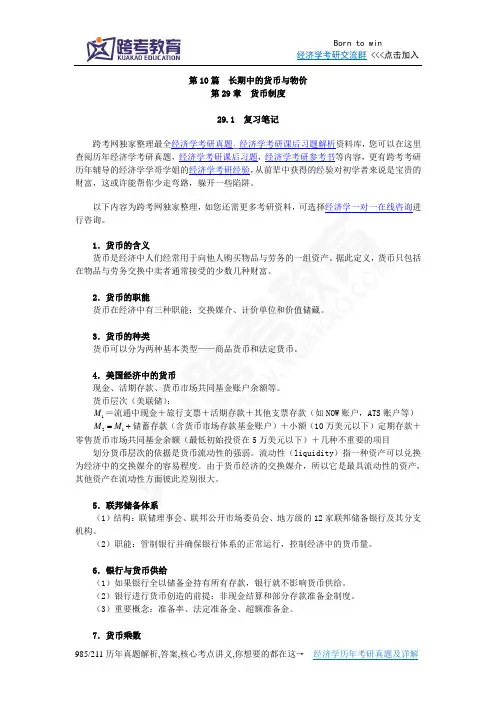
第10篇 长期中的货币与物价第29章 货币制度29.1 复习笔记跨考网独家整理最全经济学考研真题,经济学考研课后习题解析资料库,您可以在这里查阅历年经济学考研真题,经济学考研课后习题,经济学考研参考书等内容,更有跨考考研历年辅导的经济学学哥学姐的经济学考研经验,从前辈中获得的经验对初学者来说是宝贵的财富,这或许能帮你少走弯路,躲开一些陷阱。
以下内容为跨考网独家整理,如您还需更多考研资料,可选择经济学一对一在线咨询进行咨询。
1.货币的含义货币是经济中人们经常用于向他人购买物品与劳务的一组资产。
据此定义,货币只包括在物品与劳务交换中卖者通常接受的少数几种财富。
2.货币的职能货币在经济中有三种职能:交换媒介、计价单位和价值储藏。
3.货币的种类货币可以分为两种基本类型——商品货币和法定货币。
4.美国经济中的货币现金、活期存款、货币市场共同基金账户余额等。
货币层次(美联储):1M =流通中现金+旅行支票+活期存款+其他支票存款(如NOW 账户,ATS 账户等)21M M =+储蓄存款(含货币市场存款基金账户)+小额(10万美元以下)定期存款+零售货币市场共同基金余额(最低初始投资在5万美元以下)+几种不重要的项目 划分货币层次的依据是货币流动性的强弱。
流动性(liquidity )指一种资产可以兑换为经济中的交换媒介的容易程度。
由于货币经济的交换媒介,所以它是最具流动性的资产,其他资产在流动性方面彼此差别很大。
5.联邦储备体系(1)结构:联储理事会、联邦公开市场委员会、地方级的12家联邦储备银行及其分支机构。
(2)职能:管制银行并确保银行体系的正常运行,控制经济中的货币量。
6.银行与货币供给(1)如果银行全以储备金持有所有存款,银行就不影响货币供给。
(2)银行进行货币创造的前提:非现金结算和部分存款准备金制度。
(3)重要概念:准备率、法定准备金、超额准备金。
7.货币乘数货币乘数(亦称存款乘数)又称作“货币扩张系数”或“货币扩张乘数”,指的是中央银行创造或消灭一单位的基础货币所能增加或减少的货币供应量。
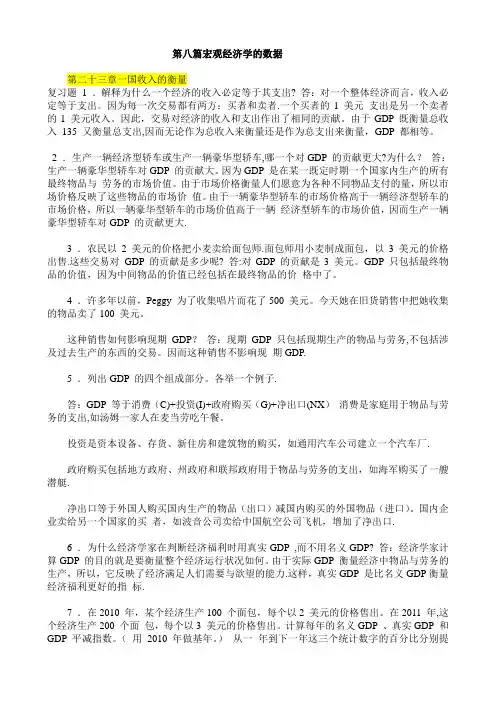
第八篇宏观经济学的数据第二十三章一国收入的衡量复习题 1 .解释为什么一个经济的收入必定等于其支出? 答:对一个整体经济而言,收入必定等于支出。
因为每一次交易都有两方:买者和卖者.一个买者的1 美元支出是另一个卖者的1 美元收入。
因此,交易对经济的收入和支出作出了相同的贡献。
由于GDP 既衡量总收入135 又衡量总支出,因而无论作为总收入来衡量还是作为总支出来衡量,GDP 都相等。
2 .生产一辆经济型轿车或生产一辆豪华型轿车,哪一个对GDP 的贡献更大?为什么?答:生产一辆豪华型轿车对GDP 的贡献大。
因为GDP 是在某一既定时期一个国家内生产的所有最终物品与劳务的市场价值。
由于市场价格衡量人们愿意为各种不同物品支付的量,所以市场价格反映了这些物品的市场价值。
由于一辆豪华型轿车的市场价格高于一辆经济型轿车的市场价格,所以一辆豪华型轿车的市场价值高于一辆经济型轿车的市场价值,因而生产一辆豪华型轿车对GDP 的贡献更大.3 .农民以2 美元的价格把小麦卖给面包师.面包师用小麦制成面包,以3 美元的价格出售.这些交易对GDP 的贡献是多少呢? 答:对GDP 的贡献是3 美元。
GDP 只包括最终物品的价值,因为中间物品的价值已经包括在最终物品的价格中了。
4 .许多年以前,Peggy 为了收集唱片而花了500 美元。
今天她在旧货销售中把她收集的物品卖了100 美元。
这种销售如何影响现期GDP?答:现期GDP 只包括现期生产的物品与劳务,不包括涉及过去生产的东西的交易。
因而这种销售不影响现期GDP.5 .列出GDP 的四个组成部分。
各举一个例子.答:GDP 等于消费(C)+投资(I)+政府购买(G)+净出口(NX)消费是家庭用于物品与劳务的支出,如汤姆一家人在麦当劳吃午餐。
投资是资本设备、存货、新住房和建筑物的购买,如通用汽车公司建立一个汽车厂.政府购买包括地方政府、州政府和联邦政府用于物品与劳务的支出,如海军购买了一艘潜艇.净出口等于外国人购买国内生产的物品(出口)减国内购买的外国物品(进口)。
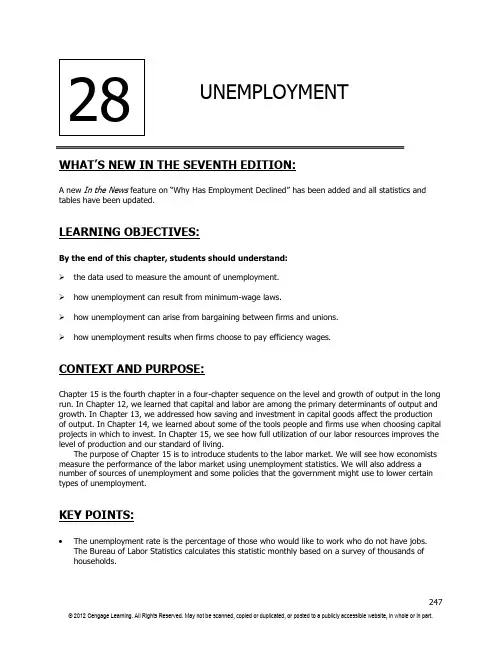
UNEMPLOYMENTWHAT’S NEW IN THE S EVENTH EDITION:A new In the News feature on “Why Has Employment Declined” has been added and all statistics and tables have been updated.LEARNING OBJECTIVES:By the end of this chapter, students should understand:the data used to measure the amount of unemployment.how unemployment can result from minimum-wage laws.how unemployment can arise from bargaining between firms and unions.how unemployment results when firms choose to pay efficiency wages.CONTEXT AND PURPOSE:Chapter 15 is the fourth chapter in a four-chapter sequence on the level and growth of output in the long run. In Chapter 12, we learned that capital and labor are among the primary determinants of output and growth. In Chapter 13, we addressed how saving and investment in capital goods affect the production of output. In Chapter 14, we learned about some of the tools people and firms use when choosing capital projects in which to invest. In Chapter 15, we see how full utilization of our labor resources improves the level of production and our standard of living.The purpose of Chapter 15 is to introduce students to the labor market. We will see how economists measure the performance of the labor market using unemployment statistics. We will also address a number of sources of unemployment and some policies that the government might use to lower certain types of unemployment.KEY POINTS:The unemployment rate is the percentage of those who would like to work who do not have jobs.The Bureau of Labor Statistics calculates this statistic monthly based on a survey of thousands of households.247248❖Chapter 15/Unemployment∙ The unemployment rate is an imperfect measure of joblessness. Some people who call themselves unemployed may actually not want to work, and some people who would like to work have left the labor force after an unsuccessful search and therefore are not counted as unemployed.∙ In the U.S. economy, most people who become unemployed find work within a short period of time.Nonetheless, most unemployment observed at any given time is attributable to the few people who are unemployed for long periods of time.∙ One reason for unemployment is the time it takes for workers to search for jobs that best suit their tastes and skills. This frictional unemployment is increased as a result of unemployment insurance, a government policy designed to protect workers’ incomes.∙ A second reason our economy always has some unemployment is minimum-wage laws. By raising the wage of unskilled and inexperienced workers above the equilibrium level, minimum-wage laws raise the quantity of labor supplied and reduce the quantity demanded. The resulting surplus of labor represents unemployment.∙ A third reason for unemployment is the market power of unions. When unions push the wages in unionized industries above the equilibrium level, they create a surplus of labor.∙ A fourth reason for unemployment is suggested by the theory of efficiency wages. According to this theory, firms find it profitable to pay wages above the equilibrium level. High wages can improve worker health, lower worker turnover, raise worker quality, and increase worker effort.CHAPTER OUTLINE:I. Unemployment can be divided into two categories.A. The economy’s natural rate of unemployment refers to the amount of unemployment that theeconomy normally experiences.B. Cyclical unemployment refers to the year-to-year fluctuations in unemployment around its naturalrate.II. Identifying UnemploymentA. How Is Unemployment Measured?1. The Bureau of Labor Statistics (BLS) surveys about 60,000 households every month.2. The BLS places each adult (age 16 or older) into one of three categories: employed,unemployed, or not in the labor force.Chapter 15/Unemployment ❖ 2493. Definition of labor force: the total number of workers, including both the employedand the unemployed .4. Definition of unemployment rate: the percentage of the labor force that isunemployed .5. Definition of labor-force participation rate: the percentage of the adult populationthat is in the labor force .6. Example: Data from 2012. In that year, there were 142.5 million employed people and 12.5million unemployed people.a. Labor Force = 142.5 + 12.5 = 155.0 million.b. Unemployment Rate = (12.5/155.0) × 100 = 8.1%.c. Because the adult population was 243.3 million, the labor-force participation rate was:Labor-Force Participation Rate = (155.0/243.3) × 100 = 63.7%.7. Table 1 shows unemployment and labor-force participation rates for various sub-groups ofthe U.S. population.ALTERNATIVE CLASSROOM EXAMPLE:The country of Bada has collected the following information:Population 240,000 Employed 180,000 Unemployed30,000Labor Force = 180,000 + 30,000 = 210,000Unemployment rate = (30,000/210,000) × 100 = 14.3%Labor-force participation rate = (210,000/240,000) × 100 = 87.5%250 ❖ Chapter 15/Unemploymenta. Women of prime working age (25 to 54 years old) have lower rates of labor-forceparticipation than men, but once in the labor market, men and women have similar rates of unemployment.b. Prime-age blacks have similar labor-force participation rates as prime-age whites, butthey have much higher rates of unemployment.c. Teenagers have much lower rates of labor-force participation and much higher rates ofunemployment than older workers.8. Figure 2 shows the unemployment rate in the United States since 1960.B. Definition of the natural rate of unemployment: the normal rate of unemploymentaround which the unemployment rate fluctuates . C. Definition of cyclical unemployment: the deviation of unemployment from its naturalrate .D. Case Study: Labor-Force Participation of Men and Women in the U.S. Economy1. There has been a dramatic rise in the labor-force participation rates of women over the past60 years.2. Figure 3 shows this rise in the labor-force participation rate of women. The figure also showsthat the labor-force participation rates for men have actually fallen by a small amount over the same time period.E. Does the Unemployment Rate Measure What We Want It To? 1. Measuring the unemployment rate is not as straightforward as it may seem.2. There is a tremendous amount of movement into and out of the labor force.a. Many of the unemployed are new entrants or re-entrants looking for work.b. Many unemployment spells end with a person leaving the labor force as opposed toactually finding a job.3. There may be individuals who are calling themselves unemployed to qualify for governmentassistance, yet they are not trying hard to find work. These individuals are more likely not a part of the true labor force, but they will be counted as unemployed.Chapter 15/Unemployment❖251 4. Definition of discouraged workers: individuals who would like to work but havegiven up looking for a job.a. These individuals will not be counted as part of the labor force.b. Thus, while they are likely a part of the unemployed, they will not show up in theunemployment statistics.5. Table 2 presents other measures of labor underutilization calculated by the Bureau of LaborStatistics.252❖Chapter 15/UnemploymentF. How Long Are the Unemployed without Work?1. Another important variable that policymakers may be concerned with is the duration ofunemployment.2. Most spells of unemployment are short, and most unemployment observed at any given timeis long term.G. Why Are There Always Some People Unemployed?1. In an ideal labor market, wages would adjust so that the quantity of labor supplied and thequantity of labor demanded would be equal.2. However, there is always unemployment even when the economy is doing well. Theunemployment rate is never zero; it fluctuates around the natural rate.a. Definition of frictional unemployment: unemployment that results because ittakes time for workers to search for the jobs that best suit their tastes andskills.b. Definition of structural unemployment: unemployment that results because thenumber of jobs available in some labor markets is insufficient to provide a jobfor everyone who wants one.c. Three possible reasons for structural unemployment are minimum-wage laws, unions,and efficiency wages.H. FYI: The Jobs Number1. When the Bureau of Labor Statistics announces the unemployment rate each month, it alsoannounces the number of jobs the economy gained or lost.2. This information comes from a survey of 160,000 business establishments.III. Job SearchA. Definition of job search: the process by which workers find appropriate jobs given theirtastes and skills.B. Because workers differ from one another in terms of their skills and tastes and jobs differ in theirattributes, it is often difficult for workers to match with the appropriate job.C. Why Some Frictional Unemployment Is Inevitable1. Frictional unemployment often occurs because of a change in the demand for labor amongdifferent firms.Chapter 15/Unemployment❖253a. When consumers decide to stop buying a good produced by Firm A and instead startbuying a good produced by Firm B, some workers at Firm A will likely lose their jobs.b. New jobs will be created at Firm B, but it will take some time to move the displacedworkers from Firm A to Firm B.c. The result of this transition is a period of unemployment.d. The same situation can occur across industries and regions as well.2. This implies that, because the economy is always changing, frictional unemployment isinevitable. Workers in declining industries will find themselves looking for new jobs, and firmsin growing industries will be seeking new workers.D. Public Policy and Job Search1. The faster information spreads about job openings and worker availability, the more rapidlythe economy can match workers and firms.2. Government programs try to facilitate job search in various ways.a. Government-run employment agencies give out information on job vacancies.b. Public training programs can ease the transition of workers from declining to growingindustries and help disadvantaged groups escape poverty.3. Critics of these programs argue that the private labor market will do a better job of matchingworkers with employers and therefore the government should not be involved in the processof job search.E. Unemployment Insurance1. Definition of unemployment insurance: a government program that partiallyprotects workers’ incomes when they become unemployed.2. Because unemployment insurance reduces the hardship of unemployment, it also increasesthe amount of unemployment that exists.3. Many studies have shown that more generous unemployment insurance benefits lead toreduced job search effort and, as a result, more unemployment.4. In the News: Why Has Employment Declined?a. The number of Americans receiving government benefits has grown substantially recentlywhile the employment-population ratio has declined.b. This article from The Wall Street Journal discusses the incentives created by thesegovernment benefits and the effects on the annual rate of real output growth.IV. Minimum-Wage LawsA. Unemployment can also occur because of minimum-wage laws.254 ❖ Chapter 15/Unemployment1. If the minimum wage is set above the equilibrium wage in the labor market, a surplus oflabor will occur.2. While minimum-wage laws are one reason unemployment exists in the U.S. economy, theydo not affect everyone.a. The vast majority of workers in the economy have wages well above the legal minimum,so the law does not prevent most wages from adjusting to balance supply and demand.b. Minimum-wage laws therefore have the largest affect on the least skilled and leastexperienced members of the labor force, such as teenagers.B. Anytime a wage is kept above the equilibrium level for any reason, the result is unemployment.1. Other causes of this situation include unions and efficiency wages.2. This situation is different from frictional unemployment where the search for the right job isthe reason for unemployment.C FYI: Who Earns the Minimum Wage?1. In 2012, the Department of Labor released a study of which workers reported earnings at orbelow the minimum wage in 2011.a. Of those workers paid an hourly rate, about 4% of men and 6% of women reportedwages at or below the federal minimum.b. Minimum-wage workers tend to be young, with about half under the age of 25.c. Minimum-wage workers tend to be less educated. Of those workers ages 16 and overwith a high school education, only 5% earned the minimum wage.d.Minimum-wage workers are more likely to be working part time.Chapter 15/Unemployment❖255d. The industry with the highest proportion of workers with reported hourly wages at orbelow the minimum wage was leisure and hospitality.e. The proportion of workers earning the prevailing minimum wage has changedsubstantially over time, trending downward from 1979 to 2006 then increasing in 2011.The increase is partially attributable to an increase in the minimum wage.V. Unions and Collective BargainingA. Definition of union: a worker association that bargains with employers over wages andworking conditions.B. Unions play a smaller role in the U.S. economy today than they did in the past. However, unionscontinue to be prevalent in many European countries.C. The Economics of Unions1. Definition of collective bargaining: the process by which unions and firms agree onthe terms of employment.2. Unions try to negotiate for higher wages, better benefits, and better working conditions thanthe firm would offer if there were no union.3. Definition of strike: the organized withdrawal of labor from a firm by a union.4. Economists have found that union workers typically earn 10% to 20% more than similarworkers who do not belong to unions.5. This implies that unions raise the wage above the equilibrium wage, resulting inunemployment.a. Unions are often believed to cause conflict between insiders (who benefit from highunion wages) and outsiders (who do not get the union jobs).b. Outsiders will either remain unemployed or find jobs in firms that are not unionized.c. The supply of workers in nonunion firms will increase, pushing wages at those firmsdown.D. Are Unions Good or Bad for the Economy?1. Critics of unions argue that unions are a cartel, which causes inefficiency because fewerworkers end up being hired at the higher union wage.2. Advocates of unions argue that unions are an answer to the problems that occur when a firmhas too much power in the labor market (for example, if it is the only major employer intown). In addition, by representing workers’ views, unions help firms provide the right mix ofjob attributes.VI. The Theory of Efficiency Wages256❖Chapter 15/UnemploymentA. Definition of efficiency wages: above-equilibrium wages paid by firms in order toincrease worker productivity.B. Efficiency wages raise the wage above the market equilibrium wage, resulting in unemployment.C. There are several reasons why a firm may pay efficiency wages.1. Worker Healtha. Better-paid workers can afford to eat better and can afford good medical care.b. This is more applicable in developing countries where inadequate nutrition can be asignificant problem.2. Worker Turnovera. A firm can reduce turnover by paying a wage greater than its workers could receiveelsewhere.b. This is especially helpful for firms that face high hiring and training costs.3. Worker Qualitya. Offering higher wages attracts a better pool of applicants.b. This is especially helpful for firms that are not able to perfectly gauge the quality of jobapplicants.4. Worker Efforta. Again, if a firm pays a worker more than he or she can receive elsewhere, the worker willbe more likely to try to protect his or her job by working harder.b. This is especially helpful for firms that have difficulty monitoring their workers.5. Case Study: Henry Ford and the Very Generous $5-a-Day Wagea. Henry Ford used a high wage (about twice the going rate) to attract better employees.b. After instituting this higher wage policy, the company’s production costs actually fell dueto reduced turnover, absenteeism, and shirking.SOLUTIONS TO TEXT PROBLEMS:Quick Quizzes1. The unemployment rate is measured starting with a survey of about 60,000 households. TheBLS categorizes individuals surveyed as employed, unemployed, and not in the labor force.Next, the BLS computes the labor force as the sum of the number of employed and thenumber of unemployed. Finally, the unemployment rate is calculated as the number ofunemployed divided by the labor force multiplied by 100. The unemployment rate overstates the amount of joblessness because some of those who report being unemployed may not, in fact, be trying hard to find a job. But the unemployment rate may understate the amount of joblessness because discouraged workers are considered not in the labor force even though they are workers without jobs.2. An increase in the world price of oil increases the amount of frictional unemployment as oil-producing firms increase output and employment, but other firms, such as those in the auto industry, reduce output and employment. The sectoral shift from the auto industry to oil firms causes higher frictional unemployment for a time until workers have shifted from the auto industry to the oil industry. Although no increase in unemployment is really desirable, this type of frictional unemployment is a natural outcome of the reallocation of resources between different sectors. Public policies that might affect the unemployment caused by this change in the price of oil include government-run employment agencies, which can helpautoworkers move into the oil industry, job-training programs to help workers adapt to a new industry, and unemployment insurance, which keeps workers from suffering economichardship while changing from one industry to another.3. Figure 1 shows the supply curve (S) and the demand curve (D) for labor. The wage (W) isabove the equilibrium wage (W E). The result is unemployment, equal to the amount bywhich the quantity of labor supplied (L S) exceeds the quantity of labor demanded (L D).Figure 14. A union in the auto industry raises the wages of workers employed by General Motors andFord by threatening to strike. To prevent the costs of a strike, the firms generally pay higher wages than they would if there were no union. However, the higher wages reduceemployment at General Motors and Ford. The unemployed autoworkers seek jobs elsewhere, reducing wages and increasing employment in the nonunion sector.5. There are four reasons that firms might find it profitable to pay wages above the level thatbalances the quantity of labor supplied and the quantity of labor demanded: (1) to ensurethat workers are in good health so they will be more productive; (2) to reduce workerturnover because it is costly to hire new workers; (3) to make workers eager to keep theirjobs, thus discouraging them from shirking; and (4) to attract a better pool of workers.Questions for Review1. The BLS categorizes each adult (16 years of age and older) as employed, unemployed, or notin the labor force. The labor force consists of the sum of the employed and the unemployed.The unemployment rate is the percentage of the labor force that is unemployed. The labor-force participation rate is the percentage of the total adult population that is in the laborforce.2. Unemployment is typically short term. Most people who become unemployed are able to findnew jobs fairly quickly. But most unemployment observed at any given time is attributable tothe relatively few workers who are jobless for long periods of time.3. Frictional unemployment is inevitable because the economy is always changing. Some firmsare shrinking while others are expanding. Some regions are experiencing faster growth thanother regions. Transitions of workers between firms and between regions are accompaniedby temporary unemployment.The government could help to reduce the amount of frictional unemployment through publicpolicies that provide information about job vacancies in order to match workers and jobsmore quickly, and through public training programs that help ease the transition of workersfrom declining to expanding industries and help disadvantaged groups escape poverty.4. Minimum-wage laws are a better explanation for unemployment among teenagers thanamong college graduates. Teenagers have fewer job-related skills than college graduates do,so their wages are low enough to be affected by the minimum wage. College graduates'wages generally exceed the minimum wage.5. Unions affect the natural rate of unemployment via the effect on insiders and outsiders.Because unions raise the wage above the equilibrium level, the quantity of labor demandeddeclines while the quantity supplied of labor rises, so there is unemployment. Insiders arethose who keep their jobs. Outsiders, workers who become unemployed, have two choices:either get a job in a firm that is not unionized, or remain unemployed and wait for a job toopen up in the union sector. As a result, the natural rate of unemployment is higher than itwould be without unions.6. Advocates of unions claim that unions are good for the economy because they are anantidote to the market power of the firms that hire workers and they are important forhelping firms respond efficiently to workers' concerns.7. Four reasons why a firm's profits might increase when it raises wages are: (1) better paidworkers are healthier and more productive; (2) worker turnover is reduced; (3) the firm canattract higher quality workers; and (4) worker effort is increased.Quick Check Multiple Choice1. a2. c3. b4. b5. c6. aProblems and Applications1. a. The adult population consists of the number of employed (143,322,000) plus the numberof unemployed (12,332,000) plus those not in the labor force (89,008,000), which equals244,662,000.b. The labor force consists of the number of employed (143,322,000) plus the number ofunemployed (12,332,000), which equals 155,654,000.c. The labor-force participation rate is the labor force (155,654,000) divided by the adultpopulation (244,662,000) times 100, which equals 63.6%.d. The unemployment rate is the number of unemployed (12,332,000) divided by the laborforce (155,654,000) times 100, which equals 7.9%.2. Many answers are possible.3. The fact that employment increased4.9 million while unemployment declined 2.7 million isconsistent with growth in the labor force of 2.2 million workers. The labor force constantlyincreases as the population grows and as labor-force participation increases, so the increasein the number of people employed may exceed the reduction in the number unemployed.4. a. If an auto company goes bankrupt and its workers immediate begin looking for work, theunemployment rate will rise and the employment-population ratio will fall.b. If some of the unemployed auto workers give up looking for a job, the unemploymentrate will fall and the employment-population ratio will remain the same.c. If numerous students graduate from college and cannot find work, the unemploymentrate will rise and the employment-population ratio will remain unchanged.d. If numerous students graduate from college and immediately begin new jobs, theunemployment rate will fall and the employment-population ratio will rise.e. If a stock market boom induces earlier retirement, the unemployment rate will rise andthe employment-population ratio will fall.f. Advances in health care that prolong the life of retirees will not affect the unemploymentrate and will lower the employment-population ratio.5. a. A construction worker who is laid off because of bad weather is likely to experienceshort-term unemployment, because the worker will be back to work as soon as theweather clears up.b. A manufacturing worker who loses his job at a plant in an isolated area is likely toexperience long-term unemployment, because there are probably few other employment opportunities in the area. He may need to move somewhere else to find a suitable job, which means he will be out of work for some time.c. A worker in the stagecoach industry who was laid off because of the growth of railroadsis likely to be unemployed for a long time. The worker will have a lot of trouble finding another job because his entire industry is shrinking. He will probably need to gain additional training or skills to get a job in a different industry.d. A short-order cook who loses his job when a new restaurant opens is likely to findanother job fairly quickly, perhaps even at the new restaurant, and thus will probably have only a short spell of unemployment.e. An expert welder with little education who loses his job when the company installsautomatic welding machinery is likely to be without a job for a long time, because he lacks the technological skills to keep up with the latest equipment. To remain in the welding industry, he may need to go back to school and learn the newest techniques.Figure 26. Figure 2 shows a diagram of the labor market with a binding minimum wage. At the initialminimum wage (w M,1), the quantity of labor supplied L S,1 is greater than the quantity of labor demanded L D,1, and unemployment is equal to L S,1 – L D,1. An increase in the minimum wage to w M,2 leads to an increase in the quantity of labor supplied to L S,2 and a decrease in the quantity of labor demanded to L D,2. As a result, unemployment increases as the minimum wage rises.7. a. Figure 3 illustrates the effects of a union being established in the manufacturing labormarket. In the manufacturing labor market (figure on the left), the wage rises from the non-union wage, w NU , to the union wage, w U , and the quantity of labor demanded declines from the non-union quantity of labor, L NU , to the union quantity of labordemanded, L UD . Because the wage is higher, the quantity supplied of labor increases toSupplyDemandWage Quantity of Laborw M,1w M,2 L D,2 L D,1L S,2L S,1the union quantity of labor supplied L US , so there are L US – L UD unemployed workers inthe unionized manufacturing sector.b. When those workers who become unemployed in the manufacturing sector seekemployment in the service labor market, shown in the figure on the right, the supply of labor shifts to the right from S 1 to S 2. The result is a decline in the wage in the nonunionized service sector from w 1 to w 2 and an increase in employment in the nonunionized service sector from L 1 to L 2.Figure 38. a. Wages between the two industries would be equal. If not, new workers would choosethe industry with the higher wage, pushing the wage in that industry down.b. If the country begins importing autos, the demand for domestic auto workers would fall.If the country begins to export aircraft, there would be an increase in the demand for workers in the aircraft industry.c. In the short run, wages in the auto industry would fall, while wages in the aircraftindustry would rise. Over time, new workers would move into the aircraft industry bringing its wage down until wages were equal across the two industries. d. If the wage did not adjust to its equilibrium level, there would be a shortage of workersin the aircraft industry and a surplus of labor (unemployment) in the auto industry.9. a. If a firm was not providing such benefits prior to the legislation, the curve showing thedemand for labor would shift to the left by exactly $4 at each quantity of labor, because the firm would not be willing to pay as high a wage given the increased cost of the benefits.b. If employees value the benefit by exactly $4 per hour, they would be willing to work thesame amount for a wage that is $4 less per hour, so the supply curve of labor shifts to the right by exactly $4.WageWageQuantity of LaborQuantityof LaborL UD US L NU SS 1S 2D DManufacturing Labor Market Service Labor Marketw NUw U w 1 w 21L 2。
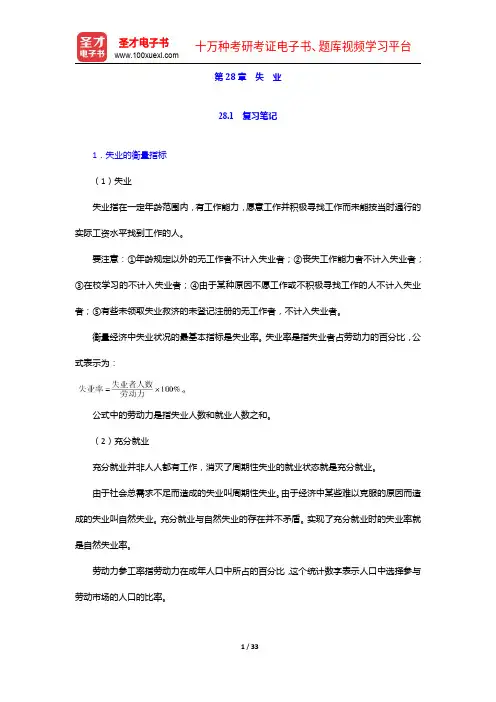
第28章失业28.1复习笔记1.失业的衡量指标(1)失业失业指在一定年龄范围内,有工作能力,愿意工作并积极寻找工作而未能按当时通行的实际工资水平找到工作的人。
要注意:①年龄规定以外的无工作者不计入失业者;②丧失工作能力者不计入失业者;③在校学习的不计入失业者;④由于某种原因不愿工作或不积极寻找工作的人不计入失业者;⑤有些未领取失业救济的未登记注册的无工作者,不计入失业者。
衡量经济中失业状况的最基本指标是失业率。
失业率是指失业者占劳动力的百分比,公式表示为:公式中的劳动力是指失业人数和就业人数之和。
(2)充分就业充分就业并非人人都有工作,消灭了周期性失业的就业状态就是充分就业。
由于社会总需求不足而造成的失业叫周期性失业。
由于经济中某些难以克服的原因而造成的失业叫自然失业。
充分就业与自然失业的存在并不矛盾。
实现了充分就业时的失业率就是自然失业率。
劳动力参工率指劳动力在成年人口中所占的百分比,这个统计数字表示人口中选择参与劳动市场的人口的比率。
经济中总存在某种失业,而且各年的失业量都在变动。
失业率围绕正常失业率而波动。
正常失业率称为自然失业率,失业率与自然失业率的背离称为周期性失业。
(3)失业率不能准确地衡量失业的原因①一些人只是为了能得到政府的福利或由于得到“暗中”支付而装作找工作,他们仍被算在劳动力之中,作为失业者。
这种行为使失业统计数字偏高。
②一些人寻找工作不成功,并放弃了寻找工作,因此他们未被算在失业者之内。
这种行为使失业统计数字偏低。
2.失业的分类宏观经济学通常将失业分为三种类型,即摩擦性失业、结构性失业以及周期性失业。
(1)摩擦性失业指劳动力在正常流动过程中所产生的失业。
摩擦性失业量的大小取决于劳动力流动性的大小和寻找工作所需要的时间。
由于在动态经济中,劳动力的流动是正常的,所以摩擦性失业的存在也是正常的。
(2)结构性失业指劳动力的供给和需求不匹配所造成的失业,其特点是既有失业,又有职位空缺,失业者或者没有合适的技能,或者居住地点不当,因此无法填补现有的职位空缺。

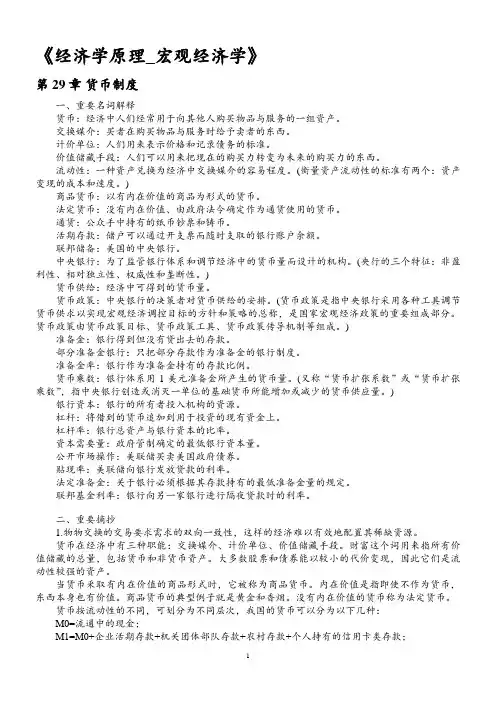
《经济学原理_宏观经济学》第29章货币制度一、重要名词解释货币:经济中人们经常用于向其他人购买物品与服务的一组资产。
交换媒介:买者在购买物品与服务时给予卖者的东西。
计价单位:人们用来表示价格和记录债务的标准。
价值储藏手段:人们可以用来把现在的购买力转变为未来的购买力的东西。
流动性:一种资产兑换为经济中交换媒介的容易程度。
(衡量资产流动性的标准有两个:资产变现的成本和速度。
)商品货币:以有内在价值的商品为形式的货币。
法定货币:没有内在价值、由政府法令确定作为通货使用的货币。
通货:公众手中持有的纸币钞票和铸币。
活期存款:储户可以通过开支票而随时支取的银行账户余额。
联邦储备:美国的中央银行。
中央银行:为了监管银行体系和调节经济中的货币量而设计的机构。
(央行的三个特征:非盈利性、相对独立性、权威性和垄断性。
)货币供给:经济中可得到的货币量。
货币政策:中央银行的决策者对货币供给的安排。
(货币政策是指中央银行采用各种工具调节货币供求以实现宏观经济调控目标的方针和策略的总称,是国家宏观经济政策的重要组成部分。
货币政策由货币政策目标、货币政策工具、货币政策传导机制等组成。
)准备金:银行得到但没有贷出去的存款。
部分准备金银行:只把部分存款作为准备金的银行制度。
准备金率:银行作为准备金持有的存款比例。
货币乘数:银行体系用1美元准备金所产生的货币量。
(又称“货币扩张系数”或“货币扩张乘数”,指中央银行创造或消灭一单位的基础货币所能增加或减少的货币供应量。
) 银行资本:银行的所有者投入机构的资源。
杠杆:将借到的货币追加到用于投资的现有资金上。
杠杆率:银行总资产与银行资本的比率。
资本需要量:政府管制确定的最低银行资本量。
公开市场操作:美联储买卖美国政府债券。
贴现率:美联储向银行发放贷款的利率。
法定准备金:关于银行必须根据其存款持有的最低准备金量的规定。
联邦基金利率:银行向另一家银行进行隔夜贷款时的利率。
二、重要摘抄1.物物交换的交易要求需求的双向一致性,这样的经济难以有效地配置其稀缺资源。
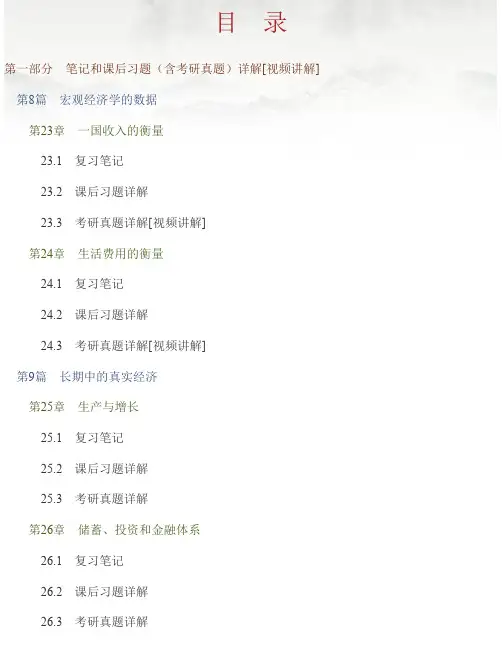
目 录第一部分 笔记和课后习题(含考研真题)详解[视频讲解]第8篇 宏观经济学的数据第23章 一国收入的衡量23.1 复习笔记23.2 课后习题详解23.3 考研真题详解[视频讲解]第24章 生活费用的衡量24.1 复习笔记24.2 课后习题详解24.3 考研真题详解[视频讲解]第9篇 长期中的真实经济第25章 生产与增长25.1 复习笔记25.2 课后习题详解25.3 考研真题详解第26章 储蓄、投资和金融体系26.1 复习笔记26.2 课后习题详解26.3 考研真题详解第27章 基本金融工具27.1 复习笔记27.2 课后习题详解27.3 考研真题详解[视频讲解]第28章 失 业28.1 复习笔记28.2 课后习题详解28.3 考研真题详解[视频讲解]第10篇 长期中的货币与物价第29章 货币制度29.1 复习笔记29.2 课后习题详解29.3 考研真题详解[视频讲解]第30章 货币增长与通货膨胀30.1 复习笔记30.2 课后习题详解30.3 考研真题详解[视频讲解]第11篇 开放经济的宏观经济学第31章 开放经济的宏观经济学:基本概念31.1 复习笔记31.2 课后习题详解[视频讲解]31.3 考研真题详解第32章 开放经济的宏观经济理论32.1 复习笔记32.2 课后习题详解[视频讲解]32.3 考研真题详解[视频讲解]第12篇 短期经济波动第33章 总需求与总供给33.1 复习笔记33.2 课后习题详解33.3 考研真题详解[视频讲解]第34章 货币政策和财政政策对总需求的影响34.1 复习笔记34.2 课后习题详解34.3 考研真题详解[视频讲解]第35章 通货膨胀与失业之间的短期权衡取舍35.1 复习笔记35.2 课后习题详解35.3 考研真题详解[视频讲解]第13篇 最后的思考第36章 宏观经济政策的六个争论问题36.1 复习笔记36.2 课后习题详解36.3 考研真题详解[视频讲解]第二部分 模拟试题及详解曼昆《经济学原理(宏观经济学分册)》(第6版)模拟试题及详解(一)曼昆《经济学原理(宏观经济学分册)》(第6版)模拟试题及详解(二)第一部分 笔记和课后习题(含考研真题)详解[视频讲解]第8篇 宏观经济学的数据第23章 一国收入的衡量23.1 复习笔记1.经济的收入与支出在一国的宏观经济中,收入必定等于支出。
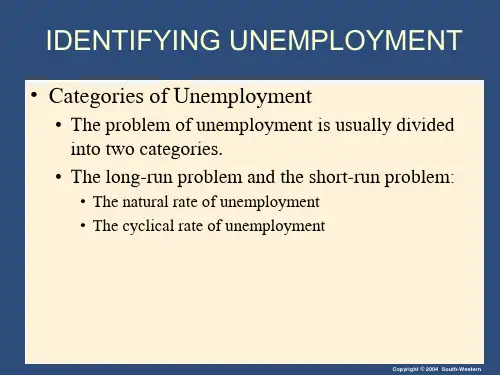
The Monetary System货币制度29货币的含义货币(Money)——经济中人们经常用来向其他人购买物品与劳务的一组资产。
货币的三大职能Medium of exchange 交换媒介 Unit of account 计价单位 Store of value 价值储藏正是这三项职能将货币跟其它资产区分开来!货币的职能•交换媒介–交换媒介——当买者在购买物品与劳务时给予卖者的东西。
–交换媒介是被乐意接受为支付的任何东西。
货币的职能•计价单位–计价单位——人们用来表示价格和记录债务的标准。
•价值储藏–价值储藏——人们可以用来把现在的购买力转变为未来的购买力的东西。
货币的流动性¾流动性(Liquidity)——一种资产可以兑换为经济中交换媒介的容易程度¾货币是流动性最强的一种资产¾物价的变动会影响货币的储藏价值货币的种类¾商品货币——以有内在价值的商品为形式的货币。
¾例子:黄金,白银,香烟¾法定货币——由政府法令而为通货使用的货币。
¾它不具有内在价值。
¾例子:硬币,纸币,存款支票美国经济中的货币¾现金——公众手中持有的纸币钞票和铸币。
¾活期存款——储户可以随时开支票的银行帐户余额。
图1. 美国经济中的货币(2004年)10亿美元•现金($580 billion)•活期存款•旅行支票’•其他支票存款($599 billion)•M1中的每一种($1,179 billion)•储蓄存款•小额定期存款•货币市场共同基金•几种不重要的项目($4,276 billion)0M1$1,179M2$5,455图2. 中国经济中的货币(截止到2007年3月末)万亿人民币•现金(2.74 )•活期存款•旅行支票’•其他支票存款(10.05)•M1中的每一种(12.79)•储蓄存款•小额定期存款•货币市场共同基金•几种不重要的项目(23.62)M112.79M236.41所有的现金都在哪里?¾在2001年,未清偿的通货有5800亿美元左右。
曼昆宏观习题答案中文版《经济学原理》宏观部分习题答案第23章《国民收入衡量》复习题:1.解释为什么一个经济的收入必定等于其指出?答:每宗交易都由卖方和买方,所以经济中支出必然等于收入。
2.生产一辆经济型轿车或生成一辆豪华型轿车,哪一个对GDP的贡献更大?为什么?答:豪华汽车市场价值高,所以对GDP贡献大。
(一对一比较)3.农民以2美元的价格把小麦卖给面包师。
面包师用小麦制成面包,以3美元的价格出售。
这些交易对GDP的贡献是多少呢?答:3元,即面包的市场价值,也即销售的最终产品。
4. 许多年以前,Peggy为了收集唱片而花了500美元。
今天她在旧货销售中把她收集的物品卖了100美元。
这种销售如何影响现期GDP?答:对现今GDP不产生影响,因为它不是现今生产出来的。
5. 列出GDP的四个组成部分。
各举一个例子。
答:消费-如购买CD。
投资-如公司购买一台电脑。
政府采购-如政府采购战机。
净出口-如美国卖小麦给俄罗斯。
6. 为什么经济学家在判断经济福利时用真实GDP,而不用名义GDP?答:因为实际GDP不受价格波动影响。
7. 在2005年,某个经济生产100个面包,每个以2美元的价格售出。
在2006年,这个经济生产200个面包,每个以3美元的价格售出。
计算每年的名义GDP、真实GDP和GDP平减指数。
(用2005年做基年。
)从一年到下一年这三个统计数字的百分比分别提高了多少?答:名义GDP 实际GDP GDP平减指数2001年200元200元 1002002年600元400元 150增长% 200% 100%50%8. 为何说一国有高的GDP是合意的?举出一个增加GDP但并不合意的例子。
答:GDP大,说明人们可以享有更多的产品和服务。
污染环境的生产,增加GDP,但是不合意。
地震过后,需要清理、重建,增加GDP,但是不合意。
应用题:1. 下列每一种交易会影响GDP的哪一部分(如果有影响的话)?解释之。
a. 家庭购买了一台新冰箱答:消费b. 姑妈买了一所新房子。
曼昆《经济学原理(宏观经济学分册)》(第6版)第28章 失 业复习笔记跨考网独家整理最全经济学考研真题,经济学考研课后习题解析资料库,您可以在这里查阅历年经济学考研真题,经济学考研课后习题,经济学考研参考书等内容,更有跨考考研历年辅导的经济学学哥学姐的经济学考研经验,从前辈中获得的经验对初学者来说是宝贵的财富,这或许能帮你少走弯路,躲开一些陷阱。
以下内容为跨考网独家整理,如您还需更多考研资料,可选择经济学一对一在线咨询进行咨询。
一、失业的确认1.如何衡量失业(1)失业失业指在一定年龄范围内,有工作能力,愿意工作并积极寻找工作而未能按当时通行的实际工资水平找到工作的人。
要注意:①年龄规定以外的无工作者不计入失业者。
②丧失工作能力者不计入失业者。
③在校学习的不计入失业者。
④由于某种原因不愿工作或不积极寻找工作的人不计入失业者。
⑤有些未领取失业救济的未登记注册的无工作者,不计入失业者。
衡量经济中失业状况的最基本指标是失业率。
失业率是指失业人数占劳动力总数的百分比,公式表示为:100%=⨯失业人数失业率劳动力人数公式中,劳动力总数是指失业人数和就业人数之和。
(2)充分就业充分就业并非人人都有工作,消灭了周期性失业的就业状态就是充分就业。
由于社会总需求不足而造成的失业称为周期性失业。
由于经济中某些难以克服的原因而造成的失业称为自然失业。
充分就业与自然失业的存在并不矛盾。
实现了充分就业时的失业率就是自然失业率。
劳动力参工率指劳动力在成年人口中所占的百分比,这个统计数字表示人口中选择参与劳动市场的人口的比率。
即:100%劳动力劳动力参工率成年人口=⨯ 经济中总存在某种失业,而且各年的失业量都在变动。
失业率围绕正常失业率而波动。
正常失业率称为自然失业率,失业率与自然失业率的背离称为周期性失业。
(3)失业率不能准确地衡量失业的原因①一些人只是为了能得到政府的福利或由于得到“暗中”支付而装着找工作,他们仍被算在劳动力之中,作为失业者。